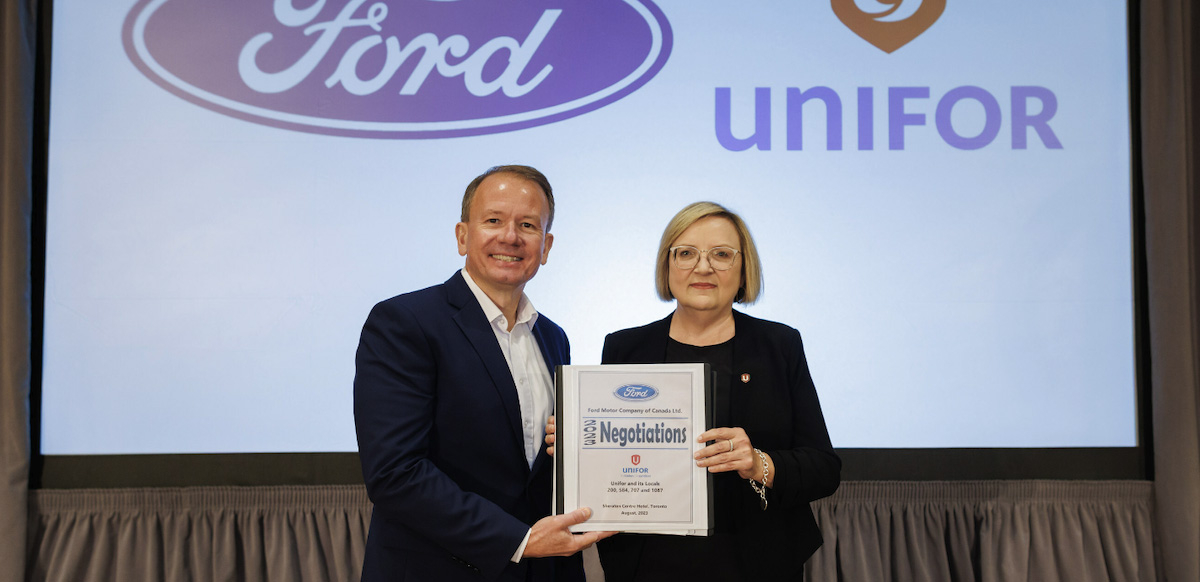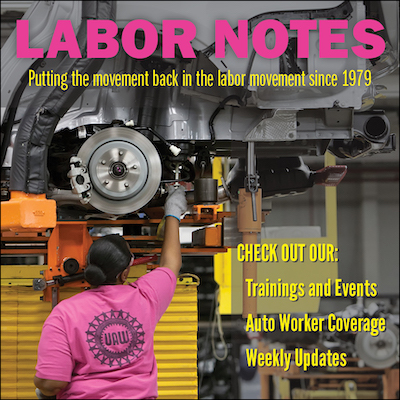Viewpoint: Auto Bargaining in Canada—Stuck in the Past?

Lana Payne, Unifor National president (right) kicked off Ford negotiations August 10. Unifor has announced a tentative agreement with Ford, but members won’t know what is in it until September 23. Photo: CNW Group/Ford of Canada.
Bargaining with the Detroit 3 auto corporations is happening in Canada and the United States at the same time this year—the first time that bargaining has aligned since the disastrous bankruptcy negotiations and forced concessions of 2009. Unifor just reached a tentative agreement with Ford earlier this week, while the United Auto Workers’ strike against selected Ford, Stellantis and General Motors plants is ongoing.
This is indicative of the major differences in the strategies of the two unions. The UAW, under new leadership, is doing things dramatically differently—raising bold demands, mobilizing their membership, and developing innovative strategies and tactics. In Canada, Unifor also has a new president, but seems to be following the bargaining approach that has become routine over the last several decades. Many Canadian auto workers are paying attention to the differences—and some comments indicate they prefer what they see from south of the border.
Details of Unifor’s agreement with Ford will be released to members on Saturday morning (September 23), with an online ratification meeting taking place later in the day. Only then will we know how Unifor's traditional approach has worked—and whether Canadian auto workers judge it to be enough.
‘CHARTING OUR OWN COURSE’
Economic and political conditions seem far better today than during the Great Recession, and there are some signs of a union upsurge. It seemed this was an opportunity for unprecedented cooperation between Unifor and the UAW to make gains for workers and reverse the losses of the last 15 years. (Unifor is the descendent of the Canadian Auto Workers, which was formed out of a split from the UAW in 1985 over disagreements in union strategy.)
Initially the two unions showed greater communication and solidarity than in the recent past. Unifor President Lana Payne was invited to speak to the UAW Bargaining Convention in March, and a meeting between the top leadership and auto bargainers of the two unions was held in Windsor, Ontario, on August 1.
However, in reporting on that meeting, the Unifor leadership stated that “different organizational and decision-making structures, different member demands for changes to each union’s individual collective agreement provisions, and different governments and political contexts under which both unions operate, necessitates a unique approach, priorities, and strategies to bargaining with Ford, General Motors and Stellantis.” “Unifor is charting its own course in Auto Talks 2023,” the union emphasized—a message that Payne has repeated during every bargaining update since.
DIFFERENT STRATEGIES ON DISPLAY
What are some of the key differences between the strategies of the two unions?
Transparency: UAW President Shawn Fain has publicly laid out the union’s bold demands in detail, and also provided the responses from the corporations (which he’s then thrown in the trash).
In Canada, Unifor has answered questions about their demands by saying they would leave that for the bargaining table. The union has provided only the vaguest description of their bargaining priorities: “Pensions, wages, transition plans as autoworkers shift to producing electric vehicles, and confirmation of new investment and product lines.”
Messaging: The UAW has consistently called out the profits of the corporations and the extravagant compensation of corporate executives. Fain has stated that the UAW is fighting for “the entire working class.”
Unifor has steered clear of criticizing the corporations, and still participates in joint photo-ops—including at the opening of negotiations. Fain, meanwhile, pointedly rejected the traditional handshake with corporate negotiators for a “members’ handshake.” Unifor provided press photos of Payne posing with the company reps while holding the demand book.
Demands: The UAW has been clear on its transformative demands, including eliminating tiers, equal pay for equal work, full seniority status for temps after 90 days, defined benefit pensions for all workers, the restoration of cost-of-living adjustments, and 40 percent wage increases.
Unifor has not publicly made any of these specific demands. The closest they have come to talking about tiers and the inequality in the workplace is to call for shortening the wage progression. Unifor contracts allow the use of temps (they are referred to as “full-time TPTs”, where TPT stands for “temporary part-time,” even though they work full-time hours including overtime and remain temps for years; the same term is used in the U.S.). For example, the Unifor-GM contract for Oshawa allows the company to use up to 15 percent full-time TPTs, who never gain seniority. Unifor has not said they are demanding an end to the use of temps.
Target Company: Unifor followed the traditional practice of choosing a target company (Ford this time), and extending the contracts and suspending negotiations at the other two companies. The UAW chose to target all three companies simultaneously.
Strike Pay: The UAW raised strike pay to $500 per week, starting on day one of a strike. Unifor has kept strike pay at $300 (Canadian) since 2019.
Zoom Ratification Votes: Unifor has announced that ratification meetings will be held by Zoom, and that voting will be online only. Ford members who are registered for this process will get the contract highlights and Zoom link by email on Saturday morning (September 23), and can attend the Zoom ratification meeting later on Saturday. They will have until 10 a.m. Sunday to vote on the tentative agreement.
An online meeting has a very different dynamic than an in-person meeting where people can interact and talk to each other. A traditional ratification meeting also allows members to express their point of view and try to influence others. The online ratification “meeting” will have the presentations by leadership, but membership participation will likely be limited to typing in questions and having them answered.
Unifor has never followed the policy of providing the full text of negotiated contract changes (the White Book) to members—only the highlights are distributed. The UAW began posting the full text of the Detroit 3 contracts online in 2011, a move American union reformer had long demanded. In 2020, 1,600 Unifor members signed a petition demanding full contract disclosure at least five days before a ratification vote.
WHAT MEMBERS ARE SAYING
Here is a selection of some online comments from Unifor members:
[After one of Unifor’s update streams] Unifor updates suck!! They can learn a lot by the way the UAW gives updates.
I don’t think the members appreciate you telling us what we “should” think. We’re all grown up out here, give us the facts so we can have a sense of direction. This over-protective band of teleprompter readers really need to pull a page from the Fain playbook.
If Unifor settles before the UAW we are doomed to an inferior contract.
Hope you do your homework, and don’t shaft us like Metro!! We won’t take anything less than the UAW. [After rejecting a tentative agreement in July, 3,700 Unifor members at Metro grocery stores in the Greater Toronto Area struck for five weeks.]
People didn’t ask for reduced tiers … they demanded to eliminate them.
Get rid of the temporary workforce that work alongside our full-time members 6-7 days a week. These people are treated as second-class citizens, it needs to stop. NO TIERS PERIOD. Equality across the board we’re all in this together.
The brother or sister beside or across from you doing the same job should be paid the same wage. Isn’t that what solidarity and being in a union is about? Time to go back to basics. Time to get these old-timers out who only know how to bargain concessionary grow-in contracts.
Tony Leah is a retired Oshawa GM worker, and long-time activist in Unifor Local 222, including being on the Master Bargaining Committee with GM in 1996.





